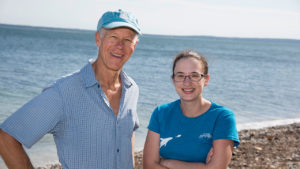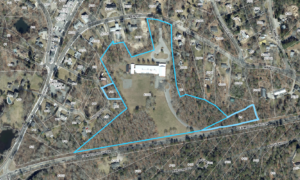
Biologist Scott Lindell and researcher Erin Fischell are part of a WHOI team working to advance the mass production of seaweed with funding from the U.S. Department of Energy’s Advanced Research Projects Agency-Energy.
Photo By Tom Kleindinst, Woods Hole Oceanographic Institution
WOODS HOLE – Homes and cars could be powered by fuel made from seaweed grown at offshore farms in the future and Woods Hole Oceanographic Institution scientists are working to make that happen as soon as possible.
WHOI was awarded a $5.7 million grant from the Department of Energy’s Advanced Research Projects Agency-Energy to develop tools and technology to advance the mass production of seaweed for biofuels.
Biologist Scott Lindell will lead the project which will build a pilot farm in the middle of Nantucket Sound sometime this fall to grow sugar kelp.
“The Department of Energy believes seaweeds could be a new feed stock, instead of corn or other sugar-based agricultural products, for biofuel production and future energy independence,” said Lindell. “They understand with the price of gas and oil the way it is now that biofuels and seaweeds are not likely to fill our tank anytime soon but we need to develop the technique and technology for maybe 10 or 20 years down the road where this will become a reality.”
About 10 percent of the fuel which is used to power motor vehicles is ethanol which is produced most typically from corn in vast fields across the Midwest.
“There’s been many criticisms of biofuel from land-based agriculture which uses more fertilizer, fresh water and arable land for something that goes into our gas tank,” Lindell said. “We’d like to present an alternative which requires none of those precious resources like fresh water and energy-expensive fertilizers. Seaweed provides that alternative.”
Laboratory tests indicate that using seaweed for biofuel is feasible. The challenge is developing a large enough biomass and feed stock at a viable price.
“Currently there is plenty of demand for seaweeds, particularly the sugar kelp species that we are growing, for food,” he said. “It’s developing quite a foodie trend and many people say kelp is the new kale.”
Lindell believes it will be many years before the sugar kelp saturates the food market and says the next major use for the produce would be for animal feed.
“Finally, when we are at the scale where we are feeding all the people and animals which might use this for food – I think we will have quantities in 10 to 20 years that will be suitable for producing biofuels as well,” Lindell said.
Lindell said he expects researchers to have strains of the kelp developed in the lab by this time next year to be planted in an offshore farm. The kelp would then be examined when it is harvested late in the spring of 2019.
The grant funding is for three years, which will help begin the research through two growth cycles.
“I think between the engineering accomplishments we make and the biological advancements we’ll make a big dent in producing the tools we need to create energy efficient kelp production for biofuels,” Lindell said.
By BRIAN MERCHANT, CapeCod.com NewsCenter























